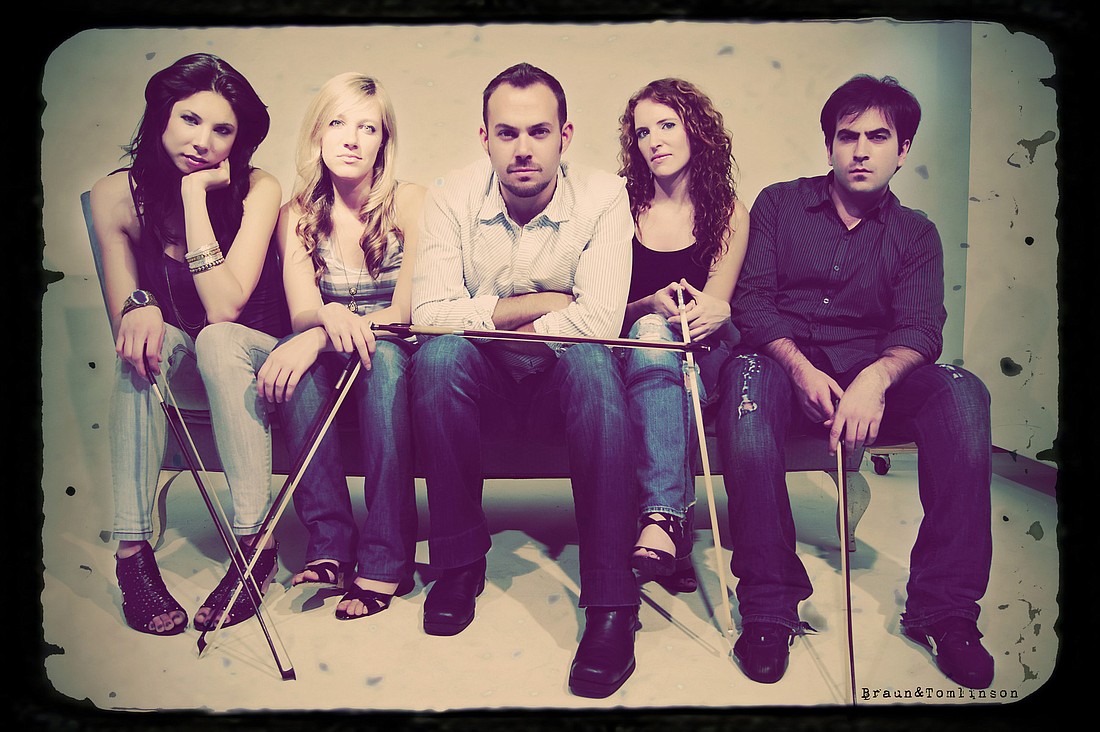- April 25, 2024
-
-
Loading

Loading

Sybarite5 is the young, effusive music group that founded Forward Fest, brought it to Sarasota and, along with its own violinists Sami Merdinian and Sarah Whitney, violist Angela Pickett, cellist Laura Metcalf and bassist Louis Levitt, added mezzo Blythe Gaissert (who happens to be married to Levitt), her pianist, Djordge Nesic, and some of Sarasota’s leading musicians, including the Chroma Quartet (Chris and Jennifer Takeda, Michael McClelland and Abe Feder), harpist Cheryl Losey (who’s newly engaged to Feder), and percussionist George Nickson. If many of these names sound familiar, it’s because we know them from their leading roles in the Sarasota Orchestra. All in the family, as it were.
Forward Fest is a forward sounding music festival that combines composers we’ve lived with most of our lives, from Debussy and Poulenc, to Bach and Kodaly, with the forward trends and premieres of young, inspiring musicians.
We attended “Words and Music,” featuring Blythe Gaissert and friends, in one of the most refreshing recital programs we’ve heard in a long time. The mezzo told us she’d chosen some of her favorite songs and, even though the unprinted program could have been seen as a mish-mosh of music, it held together beautifully because of the wholesomeness and intimacy the performers brought to it.
The most impressive work of the evening was the opening set of songs by Richard Pearson Thomas, a young, voraciously talented composer with a vivid imagination and ingenious ideas. In his “ossessione,” set for mezzo, piano and string quartet, Thomas took four well-known Italian songs from the 17th and 18th century and reset the melodies and words into a cycle reminiscent of “Pulcinella,” in which Stravinsky took some songs of the same period, including Pergolesi’s “Se TU m’ami,” and gave them a distinctly 20th century twist.
Thomas’ take is a little like what Stravinsky might have done had he been living today. Taking Bononcini’s spirited, happy “Per la Gloria d’adorarvi” and pairing it with Caldara’s more dramatic and minor-key “Comme raggio di Sol,” he formed a brilliant pastiche of new music that Gaissert, Nesic and Chroma spun into a beautifully textured chamber piece.
Caccini’s “Amarilli,” is one of the most beautiful of those “24 Italian Songs and Arias” with which every singer breaks a vocal fold or two when first learning to sing. Thomas changes the rules of “Amarilli” by having the pianist lean inside his instrument and strike the strings in a chant-like rhythm, while the mezzo sings much of the original song like a Sephardic Raga filled with melismas and what sounded like flatted quarter tones that make the music brilliant and touching. Of all, it was the most interesting and creative.
Finally, Thomas used Giordani’s “Caro mio ben” and hid its famous melody in an individual and resourceful setting that ended with the piano playing in a different key under pizzicato strings.
After that, the rest of the program seemed almost benign although Gaissert did some aptly sensuous singing in two songs by Poulenc, and a trio of touching but depressingly sad songs by Frank Bridge, assisted with passion and beauty of tone by violist Michael McClelland, which she dedicated to the memory of Jon Partridge, a dear friend of members of the Sarasota Orchestra family.
It was at this point the program started walking a fine line between personal and self-indulgent. Gaissert’s performance of “The Song of Good Hope,” sung while strumming the guitar (which she admitted she’d not played in public for many years), would have been more successful with an accompanist and more interesting arrangement. The songs by Bjork were equally down, even with the dance rhythms provided by violin and bass, and the final three songs — Herbert’s “Gypsy Love Song,” Grieg’s “Ich Liebe Dich” and the famous “Because” — were something of a comedown after the inventiveness of the newer works. Her encore from Bizet’s “Carmen,” showed still another side of this versatile mezzo who has a voice like chocolate and honey, and connects with her audience with warmth and sincerity.